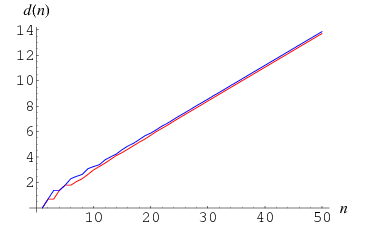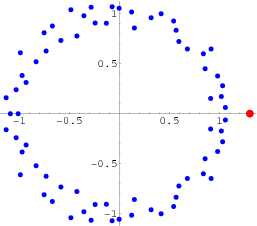

تاريخ الرياضيات

الاعداد و نظريتها

تاريخ التحليل

تار يخ الجبر

الهندسة و التبلوجي


الرياضيات في الحضارات المختلفة

العربية

اليونانية

البابلية

الصينية

المايا

المصرية

الهندية


الرياضيات المتقطعة

المنطق

اسس الرياضيات

فلسفة الرياضيات

مواضيع عامة في المنطق


الجبر

الجبر الخطي

الجبر المجرد

الجبر البولياني

مواضيع عامة في الجبر

الضبابية

نظرية المجموعات

نظرية الزمر

نظرية الحلقات والحقول

نظرية الاعداد

نظرية الفئات

حساب المتجهات

المتتاليات-المتسلسلات

المصفوفات و نظريتها

المثلثات


الهندسة

الهندسة المستوية

الهندسة غير المستوية

مواضيع عامة في الهندسة

التفاضل و التكامل


المعادلات التفاضلية و التكاملية

معادلات تفاضلية

معادلات تكاملية

مواضيع عامة في المعادلات


التحليل

التحليل العددي

التحليل العقدي

التحليل الدالي

مواضيع عامة في التحليل

التحليل الحقيقي

التبلوجيا

نظرية الالعاب

الاحتمالات و الاحصاء

نظرية التحكم

بحوث العمليات

نظرية الكم

الشفرات

الرياضيات التطبيقية

نظريات ومبرهنات


علماء الرياضيات

500AD

500-1499

1000to1499

1500to1599

1600to1649

1650to1699

1700to1749

1750to1779

1780to1799

1800to1819

1820to1829

1830to1839

1840to1849

1850to1859

1860to1864

1865to1869

1870to1874

1875to1879

1880to1884

1885to1889

1890to1894

1895to1899

1900to1904

1905to1909

1910to1914

1915to1919

1920to1924

1925to1929

1930to1939

1940to the present

علماء الرياضيات

الرياضيات في العلوم الاخرى

بحوث و اطاريح جامعية

هل تعلم

طرائق التدريس

الرياضيات العامة

نظرية البيان
Look and Say Sequence
المؤلف:
Conway, J. H.
المصدر:
"The Weird and Wonderful Chemistry of Audioactive Decay." Eureka 46
الجزء والصفحة:
...
28-1-2021
2719
Look and Say Sequence
The integer sequence beginning with a single digit in which the next term is obtained by describing the previous term. Starting with 1, the sequence would be defined by "1, one 1, two 1s, one 2 one 1," etc., and the result is 1, 11, 21, 1211, 111221, .... Similarly, starting the sequence instead with the digit  for
for  gives
gives  , 1
, 1 , 111
, 111 , 311
, 311 , 13211
, 13211 , 111312211
, 111312211 , 31131122211
, 31131122211 , 1321132132211
, 1321132132211 , ..., as summarized in the following table.
, ..., as summarized in the following table.
 |
OEIS | sequence |
| 1 | A005150 | 1, 11, 21, 1211, 111221, 312211, 13112221, 1113213211, ... |
| 2 | A006751 | 2, 12, 1112, 3112, 132112, 1113122112, 311311222112, ... |
| 3 | A006715 | 3, 13, 1113, 3113, 132113, 1113122113, 311311222113, ... |

The number of digits in the  th term of the sequence for
th term of the sequence for  are 1, 2, 2, 4, 6, 6, 8, 10, 14, 20, 26, 34, 46, 62, ... (OEIS A005341). Similarly, the numbers of digits for the
are 1, 2, 2, 4, 6, 6, 8, 10, 14, 20, 26, 34, 46, 62, ... (OEIS A005341). Similarly, the numbers of digits for the  th term of the sequence for
th term of the sequence for  , 3, ..., are 1, 2, 4, 4, 6, 10, 12, 14, 22, 26, ... (OEIS A022471). These sequences are asymptotic to
, 3, ..., are 1, 2, 4, 4, 6, 10, 12, 14, 22, 26, ... (OEIS A022471). These sequences are asymptotic to  , where
, where
 |
 |
 |
(1) |
 |
 |
 |
(2) |
 |
 |
 |
(3) |

The quantity  is known as Conway's constant (OEIS A014715), and amazingly is given by the unique positive real root of the polynomial
is known as Conway's constant (OEIS A014715), and amazingly is given by the unique positive real root of the polynomial
 |
(4) |
all of whose roots are illustrated above.
In fact, the constant is even more general than this, applying to all starting sequences (i.e., even those starting with arbitrary starting digits), with the exception of 22, a result which follows from the cosmological theorem. Conway discovered that strings sometimes factor as a concatenation of two strings whose descendants never interfere with one another. A string with no nontrivial splittings is called an "element," and other strings are called "compounds." It is postulated that every string of 1s, 2s, and 3s that does not contain four of the same number in succession eventually "decays" into a compound of 92 special elements, named after the chemical elements.
REFERENCES:
Conway, J. H. "The Weird and Wonderful Chemistry of Audioactive Decay." Eureka 46, 5-18, 1986.
Conway, J. H. "The Weird and Wonderful Chemistry of Audioactive Decay." §5.11 in Open Problems in Communications and Computation. (Ed. T. M. Cover and B. Gopinath). New York: Springer-Verlag, pp. 173-188, 1987.
Conway, J. H. and Guy, R. K. "The Look and Say Sequence." In The Book of Numbers. New York: Springer-Verlag, pp. 208-209, 1996.
Hilgemeier, M. "Die Gleichniszahlen-Reihe." Bild der Wissensch. 12, 194-196, Dec. 1986.
Hilgemeier, M. "'One Metaphor Fits All': A Fractal Voyage with Conway's Audioactive Decay." Ch. 7 in Pickover, C. A. (Ed.). Fractal Horizons: The Future Use of Fractals. New York: St. Martin's Press, 1996.
Pickover, C. A. "Audioactive Decay." Ch. 55 in Wonders of Numbers: Adventures in Mathematics, Mind, and Meaning. Oxford, England: Oxford University Press, pp. 134-138, 2001.
Sloane, N. J. A. Sequences A005150/M4780, A005341/M0321, A006715/M2965, and A006751/M2052 in "The On-Line Encyclopedia of Integer Sequences."
Vardi, I. Computational Recreations in Mathematica. Reading, MA: Addison-Wesley, pp. 13-14, 1991.
Wolfram, S. A New Kind of Science. Champaign, IL: Wolfram Media, p. 905, 2002.
 الاكثر قراءة في نظرية الاعداد
الاكثر قراءة في نظرية الاعداد
 اخر الاخبار
اخر الاخبار
اخبار العتبة العباسية المقدسة

الآخبار الصحية















 قسم الشؤون الفكرية يصدر كتاباً يوثق تاريخ السدانة في العتبة العباسية المقدسة
قسم الشؤون الفكرية يصدر كتاباً يوثق تاريخ السدانة في العتبة العباسية المقدسة "المهمة".. إصدار قصصي يوثّق القصص الفائزة في مسابقة فتوى الدفاع المقدسة للقصة القصيرة
"المهمة".. إصدار قصصي يوثّق القصص الفائزة في مسابقة فتوى الدفاع المقدسة للقصة القصيرة (نوافذ).. إصدار أدبي يوثق القصص الفائزة في مسابقة الإمام العسكري (عليه السلام)
(نوافذ).. إصدار أدبي يوثق القصص الفائزة في مسابقة الإمام العسكري (عليه السلام)


















